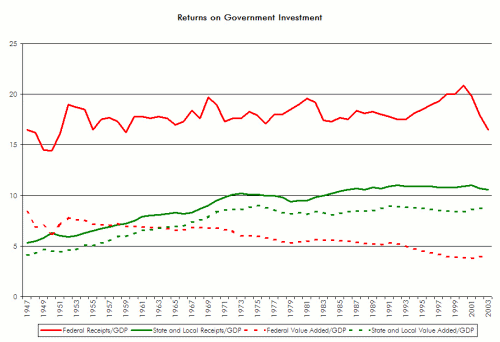Brian Gongol
Investors have a reasonable right to demand a return on their investments. Taxes are effectively an investment in government, from which taxpayers reasonably may expect a useful return.
Since 1947, the Federal government of the United States has taken between 14.4% and 20.9% of gross domestic product (GDP) each year in taxes. The low was in 1950, with the high in 2000. During that same time, state and local government tax receipts have ranged between a low of 5.3% (in 1947) and a high of 11.0% (in 1992 and 2001).
Measurements are also kept of a basic sort of return on investment: Value added to GDP. The Bureau of Economic Analysis uses the following definition:
Value added is equal to an industry's gross output (sales or receipts and other operating income, commodity taxes, and inventory change) minus its intermediate inputs (consumption of goods and services purchased from other industries or imported). Current-dollar value added is calculated as the sum of distributions by an industry to its labor and capital which are derived from the components of gross domestic income .The following graph illustrates Federal and state/local receipts as percentages of GDP (in solid colors; red for Federal, green for state/local) and value added, also as percentages of GDP (in dotted lines, using the same colors).
The picture painted is relatively clear:
- The state/local tax share of GDP is growing
- The Federal tax share of GDP has remained mainly steady for about half a century
- The state/local return on investment has risen relatively closely with increasing state/local tax receipts
- The Federal return on investment has fallen steadily since the 1940s

In a sense, it might be true that government works best when it is designed to have no return on investment at all -- that might indicate that the government was involved exclusively in areas in which the private sector had absolutely no interest, meaning that the government was appropriately staying out of sectors where it didn't belong (after all, we really don't expect the Marine Corps to turn a profit).
However, it's much more likely that what the figures represent is a government that spends more and more of its tax receipts on basic transfers of wealth. The gap between receipts and value added is now well over 10% of GDP. In other words, more than a tenth of the economy simply consists of money from one person's pile to another person's pile. At the same time as the gap between tax receipts and value added has grown, average quarterly GDP growth has declined. Taken in tandem, these two factors suggest that US government and economic policy are being dedicated ever more to redistribution and ever less to growth.
The long-term ramifications are both very serious and very unpleasant: Growth is the primary driver of standards of living as well as of a nation's status in world affairs. A nation without a dedication to growth is ensuring its own eventual decline.
